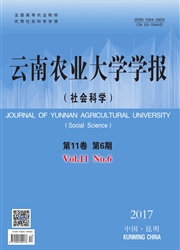

 中文摘要:
中文摘要:
采用菌丝生长速率法和凹玻片法测定了大蒜各部位挥发物和浸提液对辣椒疫霉菌各生育阶段的抑菌活性,并用GC-MS深入分析了大蒜浸提液中的抑菌活性成分,以期为利用大蒜和辣椒轮作或间作控制辣椒疫病提供指导.试验结果表明,大蒜各组织挥发物和浸提液对辣椒疫霉菌均具有抑菌活性,其中蒜瓣抑菌活性最强,挥发物浓度0.3g/皿即完全抑制辣椒疫霉菌菌丝生长,浸提液浓度16.7 mg/mL时的抑制率为67.09%.蒜瓣浸提液浓度2 mg/mL时对辣椒疫霉菌游动孢子释放、休止和萌发的抑制率分别为18.44%,100%和100%.GC-MS分析表明,3种组织浸提液中均含有多种含硫化合物,包括二烯丙基一硫化物(DAS)、二烯丙基二硫化物(DADS)、二烯丙基三硫化物(DATS)和二甲基三硫化物(DMTS)等.化合物单体活性验证结果表明,DADS、DATS和DMTS均具有抑菌活性,其中二烯丙基三硫化物(DATS)抑菌活性最强,浓度100 mg/L时抑制率为47.30%.综上所述,大蒜不同组织产生和释放的含硫化合物对辣椒疫霉菌具有杀菌活性,生产上可以利用大蒜和辣椒间作或轮作降低辣椒疫病的危害.
 英文摘要:
英文摘要:
In this study,the inhibitory activity of volatiles and extracts of garlic cloves,leaves and roots against Phytophthora capsici was determined with the method of hyphal growth inhibition assay and concave slide assay.And the compounds in the extracts were further identified by GC-MS.The results indicated that the volatiles and extracts of garlic had strong inhibitory activity against P.capsici.Especially,the inhibitory activity of garlic clove was higher than that of leaf and root.The volatiles of garlic clove can completely inhibit the growth of hyphae at a concentration of 0.3 g/dish.The inhibitory rate of extracts of garlic clove to hyphae growth was 67.09% at a concentration of 16.7 mg/mL and to zoospore releasing,swimming and cystospore germination was 18.44%,100% and 100% at a concentration of 2 mg/mL.The results of GC-MS demonstrated that there were several kinds of sulfur compounds in the extracts of garlic cloves,leaves and roots.Further analysis indicated that diallyl disulfide (DADS),diallyl trisulfide (DATS) and dimethyl trisulfide (DMTS) showed inhibitory activity against the growth of hyphae.DATS had the strongest inhibitory activity.The inhibitory rate reached to 47.30% at concentration of 100 mg/L.Based on the above,the compounds produced and released from garlic tissues can strongly inhibit the growth of P.capsici,which imply that garlic can be utilized to control pepper Phytophthora blight with the method of intercropping or rotation with pepper.
 同期刊论文项目
同期刊论文项目
 同项目期刊论文
同项目期刊论文
 期刊信息
期刊信息
